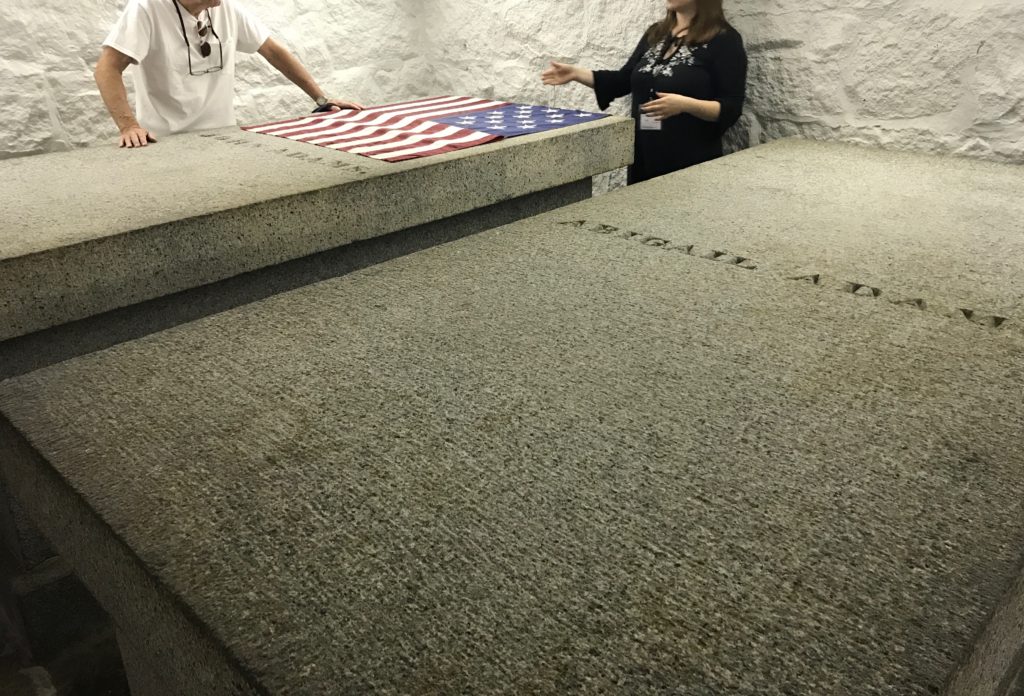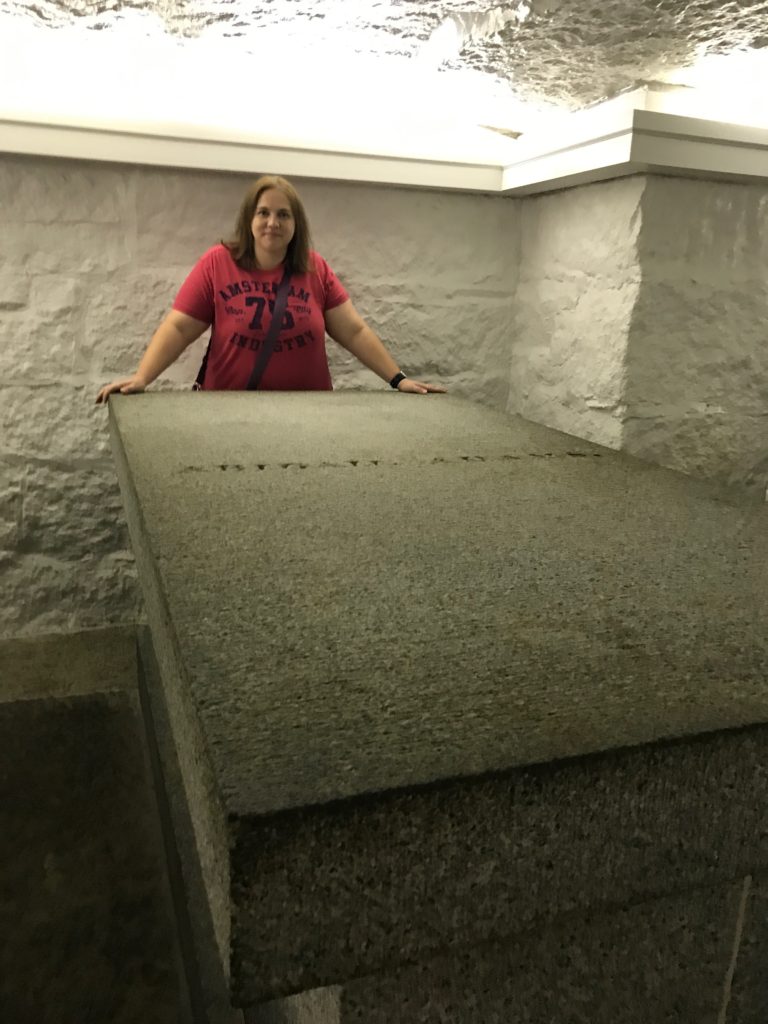If John Quincy Adams was still alive, today would be his 251st birthday. But he’s not still alive. He’s dead. In honor of this, and of the 192nd anniversary of John (not Quincy) Adams’s death last week, this weeks’ post with cover my visit to their final resting place.
- Presidents: John Adams and John Quincy Adams
- Location: Quincy, Massachusetts
- Operated By: United First Parish Church
- When Visited: July 9, 2017
- Who with: A growing collection of random strangers (I visited the site solo).
- Presidential Significance: This was the church the Adamses attended (although not necessarily in this building), and both President Adamses are buried in a crypt in the basement.
- Pre-Visit Reading: No reading specific to these presidents, but I did watch the HBO miniseries John Adams starring Paul Giamatti.
I visited the United First Parish Church in July 2017 as part of a New England trip I took with my friend, Sara. Perhaps overwhelmed by the three presidential sites we had already visited in previous few days, she opted to do other, non-presidential things in Boston while I made a pilgrimage to Quincy to experience all things Adams. Weirdo.
The church sits just across the street from the visitor center for the Adams National Historic Park, which is run by the National Parks Service. The church is not part of the park and is independently operated. Fortunately, the church encourages visitors and has volunteers that will gladly give you a tour and take you to the crypt in the basement where both presidents are interred.
I headed over to the church after visiting the NPS site. Since I had just finished a tour with around 20 people on it, I was surprised that I was the only one to follow it up with a visit to the church. It didn’t matter, though, as the tour guide didn’t seem bothered to do a tour for only one person. It was all pretty casual. There appeared to be no set tour times, they just did a tour whenever people showed up. I stuck a few dollars in the voluntary donation jar and we started the tour.
The short tour basically starts in the sanctuary and then heads downstairs to the crypt. The tour guide pointed out architectural features of the church (it really was nice), as well as some items donated by the Adams family. Multiple generations of the family attended this church, and both presidents were lifelong members, although John Quincy Adams was the only one to attend in this building. While the elder John Adams largely financed the currently building (the church’s fourth, replacing a wooden structure on the same site), it was not completed until 1828, two years after his death.
Around the time we were discussing the Adams pew (see the pic below), a couple of other people who had been on my last tour showed up and joined us. We were all invited to sit in the Adams pew if we wanted, but I passed. It seemed maybe a bit awkward to sit while the others watched me soak it all in. What if I didn’t have an adequately spiritual and transcendent experience from resting my ass in the same spot that John Quincy Adams once rested his? I would just let everyone down.
As we were wrapping up in the sanctuary, another group wandered in. Literally wandered. They seemed to have very little clue as to what there was to see or what they were even doing there. There was a woman in her 50s or 60s, her elderly father, and a couple other men. From what I can gather, they happened to be walking by when they saw the sign sitting out front advertising the tour so they walked inside.
“What are you looking at!? What’s in here?!” asked the elderly gentleman loudly and bluntly, in that way that octogenarians can get away with but that would be considered rude if it was me. The tour guide kindly explained what the tour covered. The fact that there were dead presidents stashed away in the basement came as a pleasant surprise to our new friends. The woman had actually lived in Quincy her whole life and never even knew that they were burried there! I know this because she mentioned it about, oh, 17,000 times during the rest of the tour (which they joined us for).
Our tour guide did a brief recap of what she had already pointed out in the sanctuary for the sake of the newest tour members, then we headed downstairs. The anticipation was building, but before the tomb there was another stop to discuss the history of the church buildings. Here we saw a scale model of the wooden structure that preceded the current building, along with a piece of wood and a weather vane from the old building. This was great, but then came the climax of the tour: the Adams crypt.
The crypt was tiny, and not for those with claustrophophia. The ceiling was low, and the room was just big enough for visitors to move single file around the four sarcophagi holding the two presidents and their first ladies. The entrance was not quite in the center of the crypt, making John and Abigail the easiest to get to, while John Quincy and especially his wife, Louisa (who, up until 2017, was our only foreign-born first lady), were a little more tucked away.
I’m always a little unsure what level of photography is appropriate for certain places I visit, like a crypt. Is it OK to take a picture (and should I smile)? I first tried to slyly take a selfie, but failed (much like both of these presidents failed in securing a second term, bah-dum-pah!). It’s a really tight space and not selfie-friendly. So I gave up being discreet and asked the lady who had lived in Quincy her whole life and never knew this was here to take my picture. We held an impromptu photo session, with me posing at different spots around the crypt. As she hand me back my phone, she let me know she had lived in Quincy her whole life and never knew this was here (this lady actually was really pleasant and nice, she just happened too be only slightly less repetitive than Hodor or Groot).
That was pretty much it. After the crypt we headed back upstairs and went our separate ways, to go on the rest of our lives (whether in Quincy or elsewhere) knowing that this was there. Overall, this was a nice quick (I was there maybe 30 minutes total) presidential history stop, and paired well with the tour of the Adams homes offered at the NPS site across the street.






